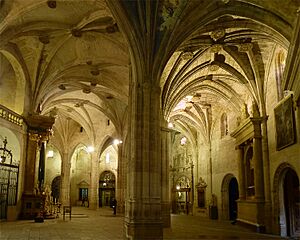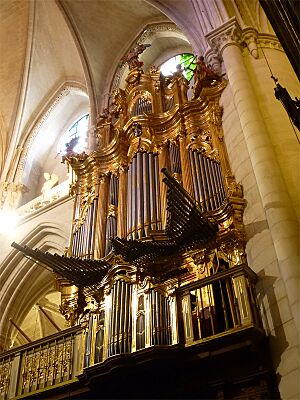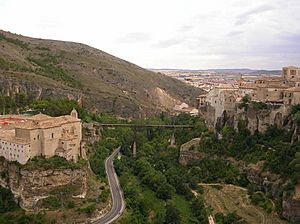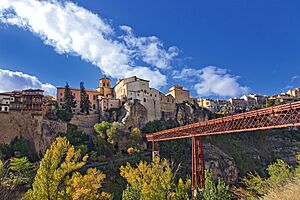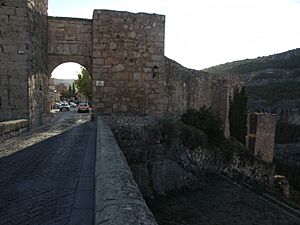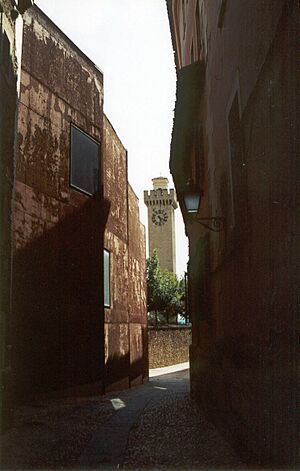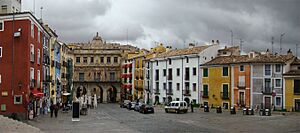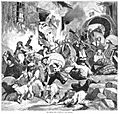Cuenca, Spain facts for kids
Quick facts for kids
Cuenca
|
|||
|---|---|---|---|
|
|
|||
|
|||
| Country | Spain | ||
| Autonomous community | Castile–La Mancha | ||
| Province | Cuenca | ||
| Comarca | Serranía Media | ||
| Area | |||
| • Total | 911.06 km2 (351.76 sq mi) | ||
| Elevation | 946 m (3,104 ft) | ||
| Population
(2018)
|
|||
| • Total | 54,898 | ||
| • Density | 60.2573/km2 (156.0656/sq mi) | ||
| Demonym(s) | Conquense | ||
| Time zone | UTC+1 (CET) | ||
| • Summer (DST) | UTC+2 (CEST) | ||
| Postal code |
16000
|
||
Cuenca is a city and municipality in Spain. It's located in the region of Castilla–La Mancha. Cuenca is also the capital city of the Cuenca province.
Contents
- What's in a Name?
- A Look Back in Time
- Nature and Weather
- Must-See Sights
- Cuenca Cathedral
- Church of Saint Peter
- Church of Saint Michael
- Church of Our Savior
- Bridge of Saint Paul
- Seminary
- Old Convent of Saint Paul
- Bishop's Palace
- The Castle
- Mangana Tower
- Town Hall
- Hanging Houses
- Monument to the Sacred Heart of Jesus
- Cuenca Province Council
- Museums to Explore
- Parks and Green Spaces
- Fun Festivals
- Getting Around
- Sister Cities
- Tasty Food
- Images for kids
- See also
What's in a Name?
The name Cuenca might come from the Latin word conca, which means "river basin". This makes sense because the city is built around the deep gorges of the Júcar and Huécar rivers. Another idea is that it comes from an old Arab castle called Kunka. Some people even called it the "Eagle's Nest" because of its high and tricky location on the edge of a gorge!
A Look Back in Time
Early Days
Long ago, when the area of Spain was part of the Roman Empire, there were important towns nearby. But the spot where Cuenca is today was empty.
When Muslim people arrived in 714, they saw how perfect this place was for a fort. They built a strong fortress called Kunka between the Júcar and Huécar river gorges. It was surrounded by a 1-kilometer-long wall. Cuenca quickly became known for farming and making cloth, and it grew quite rich.
Christian Reconquest
In the 11th century, Spain was divided into many small Muslim kingdoms called taifas. Cuenca was part of the kingdom of Toledo. Over time, Christian kings tried to take control of Cuenca.
In 1177, after a long fight, King Alfonso VIII of Castile and his allies finally conquered Cuenca from the Muslim rulers. This was a very important moment for the city.
Growing City
After being conquered, Cuenca received special laws called the Fuero. These laws helped the city grow and become well-organized. In 1183, the church leadership was set up here. St. Julian of Cuenca, who is now the city's patron saint, was the second bishop.
Alfonso X officially called Cuenca a 'city' in 1257. For the next few centuries, Cuenca did very well, thanks to its cloth-making and farming. The beautiful cathedral started to be built around this time. It was designed in an early Gothic style, influenced by King Alfonso VIII's wife, Eleanor, who was from England.
Hard Times and Recovery
In the 18th century, Cuenca's cloth industry faced problems. The city's economy suffered, and many people left. During the war against Napoleon's troops in the early 1800s, Cuenca was badly damaged.
Things slowly got better in the 19th century with the arrival of railroads and the timber industry. But in 1874, during a conflict called the Third Carlist War, Cuenca was attacked again and suffered more damage.
The 20th century brought more challenges, including the collapse of a cathedral tower in 1902. During the Spanish Civil War, Cuenca was part of the side that supported the Republic. After the war, the area faced tough economic times, and many people moved away to find work.
Modern Cuenca
Since the 1960s, Cuenca has slowly started to recover. The city has grown beyond its old walls. In recent years, tourism has become very important.
A big moment for Cuenca was in 1996 when it was named a World Heritage Site by UNESCO. This means its historic parts are protected for their special cultural value. The city has also added new cultural places, like a concert hall and a science museum.
Nature and Weather
Cuenca is built on a steep hill, with deep gorges carved by the Júcar and Huécar rivers. The city has two main parts: the "new" city and the older, historic part.
The weather in Cuenca is typical for Spain's inner plateau. Winters can be quite cold, but summers are hot during the day. Spring and autumn are short, with pleasant days but cool nights, especially because the city is high up, around 950 to 1000 meters above sea level.
| Climate data for Cuenca 948 m (1981–2010) | |||||||||||||
|---|---|---|---|---|---|---|---|---|---|---|---|---|---|
| Month | Jan | Feb | Mar | Apr | May | Jun | Jul | Aug | Sep | Oct | Nov | Dec | Year |
| Record high °C (°F) | 22.6 (72.7) |
24.5 (76.1) |
26.9 (80.4) |
29.0 (84.2) |
35.1 (95.2) |
38.0 (100.4) |
39.6 (103.3) |
39.7 (103.5) |
38.2 (100.8) |
31.5 (88.7) |
25.5 (77.9) |
21.2 (70.2) |
39.7 (103.5) |
| Mean daily maximum °C (°F) | 9.7 (49.5) |
11.5 (52.7) |
15.1 (59.2) |
16.6 (61.9) |
20.9 (69.6) |
27.3 (81.1) |
31.4 (88.5) |
30.7 (87.3) |
25.6 (78.1) |
19.2 (66.6) |
13.3 (55.9) |
10.1 (50.2) |
19.3 (66.7) |
| Daily mean °C (°F) | 4.6 (40.3) |
5.9 (42.6) |
8.8 (47.8) |
10.6 (51.1) |
14.6 (58.3) |
20.1 (68.2) |
23.6 (74.5) |
23.2 (73.8) |
18.8 (65.8) |
13.4 (56.1) |
8.3 (46.9) |
5.4 (41.7) |
13.1 (55.6) |
| Mean daily minimum °C (°F) | −0.5 (31.1) |
0.2 (32.4) |
2.5 (36.5) |
4.5 (40.1) |
8.2 (46.8) |
12.8 (55.0) |
15.7 (60.3) |
15.6 (60.1) |
11.9 (53.4) |
7.7 (45.9) |
3.2 (37.8) |
0.7 (33.3) |
6.9 (44.4) |
| Record low °C (°F) | −17.8 (0.0) |
−14.5 (5.9) |
−15.6 (3.9) |
−5.8 (21.6) |
−1.4 (29.5) |
1.6 (34.9) |
3.5 (38.3) |
4.8 (40.6) |
1.2 (34.2) |
−4.6 (23.7) |
−8.2 (17.2) |
−12.8 (9.0) |
−17.8 (0.0) |
| Average precipitation mm (inches) | 40 (1.6) |
38 (1.5) |
35 (1.4) |
58 (2.3) |
52 (2.0) |
41 (1.6) |
10 (0.4) |
20 (0.8) |
42 (1.7) |
60 (2.4) |
48 (1.9) |
58 (2.3) |
501 (19.7) |
| Average precipitation days (≥ 1 mm) | 6.5 | 5.9 | 5.5 | 8.4 | 8.3 | 4.6 | 1.7 | 2.6 | 4.8 | 7.9 | 7.2 | 8 | 71.4 |
| Average snowy days | 2.3 | 2 | 1.1 | 0.7 | 0 | 0 | 0 | 0 | 0 | 0.1 | 0.8 | 1.3 | 8.3 |
| Average relative humidity (%) | 73 | 67 | 60 | 60 | 56 | 48 | 41 | 45 | 55 | 67 | 73 | 76 | 60 |
| Mean monthly sunshine hours | 154 | 162 | 211 | 206 | 258 | 309 | 357 | 329 | 246 | 188 | 151 | 136 | 2,707 |
| Source: Agencia Estatal de Meteorología | |||||||||||||
| UNESCO World Heritage Site | |
|---|---|
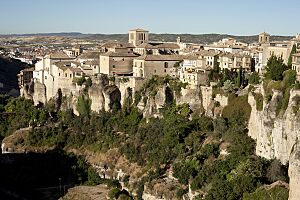 |
|
| Criteria | Cultural: ii, v |
| Inscription | 1996 (20th Session) |
| Area | 22.79 ha |
| Buffer zone | 170.49 ha |
Must-See Sights
Cuenca Cathedral
Cuenca Cathedral was built between 1182 and 1270. It was one of the first Gothic-style cathedrals in Spain. This was thanks to the influence of Queen Eleanor, who was the wife of King Alfonso VIII. She brought the Anglo-Norman style from England.
The cathedral has changed over the centuries. Parts were added in the 15th and 16th centuries. The main front of the building had to be rebuilt in 1902 after a tower collapsed. Today, you can see beautiful modern stained-glass windows and restored old organs.
Church of Saint Peter
The Church of Saint Peter (San Pedro) started as a Romanesque church. It was rebuilt in the 18th century in a Baroque style. It looks octagonal from the outside but is round inside. You can find it in Plaza del Trabuco.
Church of Saint Michael
The Church of Saint Michael (Iglesia de San Miguel) was built in the 13th century. Over time, more parts were added, like a second nave and a dome.
Today, this church is used for classical music concerts. It's one of the main places for the Religious Music Week festival. You can find it near Plaza Mayor.
Church of Our Savior
This church (Iglesia del Salvador) was built in the 18th century in a Neo-Gothic style. It has one tall tower and some lovely Baroque altars inside.
A famous religious parade called "Las Turbas" starts here on Good Friday morning. The important statue of "Jesús el Nazareno" is kept inside this church.
Bridge of Saint Paul
The Bridge of Saint Paul (Puente de San Pablo) was first built between 1533 and 1589. It was made to connect the old town with the St Paul convent across the Huecar River gorge.
The original bridge fell down. The one you see today was built in 1902. It's made of wood and iron and stands about 40 meters high. It's a great spot for photos!
Seminary
The Seminary is a large building that was built around 1745. It has a beautiful Baroque front. Inside, it has a library with many old books, some from before 1501!
Today, it trains future priests.
Old Convent of Saint Paul
The Convent of Saint Paul was built in the 16th century by a monk from the Dominican Order. The church part was finished in the 18th century in a fancy Rococo style.
For many years, it was a convent for monks. But in the 1990s, it was restored and turned into a hotel called the Parador Nacional de Turismo. You can still visit parts of the convent and the church.
Bishop's Palace
The Bishop's Palace houses the Diocese's Museum. This museum has an amazing collection of religious art. You can easily get to it from the cathedral.
The museum displays special items like a Byzantine Diptych (a book-like silver artwork from around 1370) and paintings by the famous artist El Greco.
The Castle
El Castillo means "The Castle." These are the remains of an old Arab fortress, which are the oldest structures in Cuenca. Only a tower, some stone blocks, an arch, and a piece of the walls are left. The arch is called arco de Bezudo, named after a knight who helped King Alfonso VIII of Castile conquer Cuenca.
The castle was later used by the Inquisition after 1583. It was destroyed in the 19th century by French soldiers during a war.
Mangana Tower
The Mangana Tower has a long history, but its exact beginnings are not clear. It was damaged by lightning and by French soldiers in the 19th century. It was rebuilt several times.
Today, it has a clock and you can hear bell sounds from it in the old town. From viewpoints nearby, you can see great views of the Jucar River gorge and the newer parts of the city.
Town Hall
The Town Hall is a Baroque-style building. It was finished in 1762. It stands on three Roman arches. The middle arch is the only one that cars can drive through to get to Plaza Mayor.
Hanging Houses
The Casas Colgadas, or Hanging Houses, are built right on the edge of a rock above the Huecar River gorge. They were built in the 15th century. These are the only examples left of this type of building, which used to be common in Cuenca.
The Hanging Houses are Cuenca's most famous buildings. They have a restaurant and the Museum of Abstract Arts inside. They are a popular spot for tourists to take photos from the Bridge of San Pablo.
Monument to the Sacred Heart of Jesus
On top of the Cerro del Socorro hill, you'll find a monument to the Holy Heart of Jesus. The materials for it were carried up by donkeys in the mid-20th century! This spot offers amazing views of the city.
Cuenca Province Council
The building for the provincial council (Diputación provincial de Cuenca) was built in the early 20th century. You can see Cuenca's coat of arms on its front, made from Carrara marble.
Museums to Explore
Cuenca has several interesting museums:
- Archeological Museum: See items from the ancient Roman city of Segobriga.
- Diocese's Museum: Home to a special collection of religious art.
- Museum of Spanish Abstract Art: Discover modern abstract artworks.
- Museum of Science of Castile-La Mancha: Learn about science in a fun way.
- Holy Week Museum of Cuenca: Explore the history and traditions of Cuenca's Holy Week celebrations.
- Fundación Antonio Pérez
- Fundación Antonio Saura

Parks and Green Spaces
- El Escardillo: A small park in the old town with trees and a fountain.
- Los Moralejos: A larger park near the city entrance, great for biking.
- Santa Ana: Located near the bullring, with large trees providing shade.
- San Fernando: In the newer part of Cuenca, this park has three small lakes.
- San Julián: The oldest park in Cuenca, created in the early 1900s. It has a unique design with large trees and sand paths.
Fun Festivals
- Jueves Lardero: A traditional celebration.
- St. Julian's Day: On January 28th, celebrating Julian of Cuenca, the city's patron saint.
- Saint Matthew's Day: On September 21st, a lively four-day festival. Young bulls are led through the streets, and people gather in groups called "peñas" to eat and drink.
- Holy Week: A very important religious festival in Cuenca, known for its processions. It's considered a Fiesta of International Tourist Interest of Spain.
Getting Around
Cuenca has good transport links. A high-speed train (AVE) connects Cuenca to Madrid and Valencia. The journey to Madrid takes only about 50 minutes, and to Valencia about an hour. The high-speed train station is a few kilometers from the city center, connected by a bus.
You can also travel by bus between Madrid and Cuenca, which takes about 2 to 2.5 hours. The A-40 motorway connects Cuenca to other major roads, making it easy to drive to Madrid and Valencia.
Sister Cities
Cuenca is connected with other cities around the world. These are called "twin towns" or "sister cities":
Tasty Food
Cuenca's food mixes dishes from its mountain (Serranía) and plain (Mancha) areas. Here are some typical foods:
- Ajo arriero: A spread made from cod fish, potato, and garlic.
- Cordero: Pieces of lamb, either roasted or in a stew.
- Morteruelo: A type of pâté made from different meats, like hare, partridge, chicken, and pork.
- Pisto manchego: A mix of chopped and fried vegetables like tomato, pepper, and zucchini. It's similar to French ratatouille.
- Queso manchego: A cheese made only from sheep's milk, often from nearby towns.
- Setas: In autumn, you can find many kinds of mushrooms in the forests near Cuenca.
- Trucha: Trout fish from the mountain rivers, usually grilled.
- Oreja, Forro, Panceta: Different cuts of pork, usually grilled.
- Mojete: A traditional tomato salad.
For dessert, try Alajú, an Arab cake made with honey, almonds, nuts, and orange peel. Resoli is a special drink, often served with ice after a meal.
Images for kids
See also
 In Spanish: Cuenca (España) para niños
In Spanish: Cuenca (España) para niños
- Ciudad Encantada: A cool place with unusual rock formations near Cuenca.
- The Valley of Gwangi: Parts of this 1969 fantasy film were shot in Cuenca's Plaza Mayor and Cathedral.
- Sound of the Sky: A Japanese anime series that uses Cuenca as inspiration for its fictional town, Seize.









